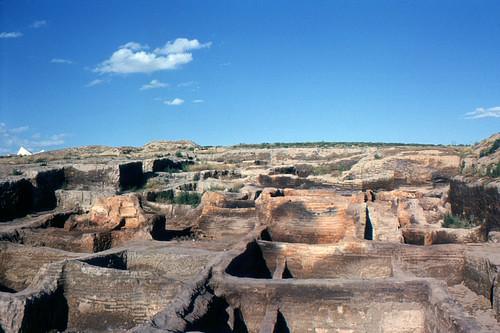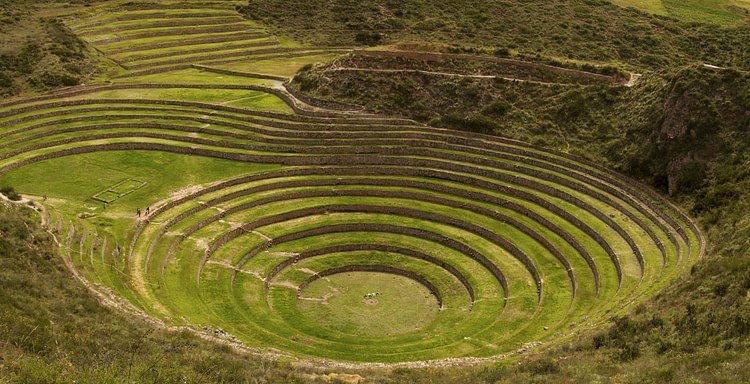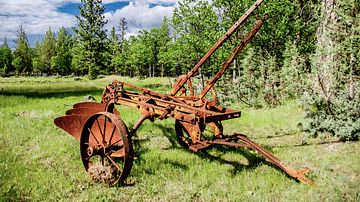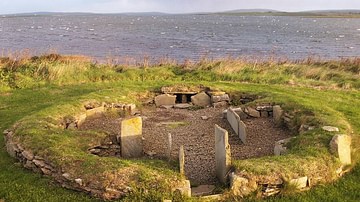The Neolithic Revolution began between 10,000 and 12,000 years ago at several widely dispersed locations across the world, when our ancestors first began planting and raising crops. Agricultural communities sprang up almost simultaneously in Mesopotamia, China, Southeast Asia, Africa, Mesoamerica, and South America replacing the hunter-gatherer mode of subsistence that had been utilized for hundreds of thousands of years by Homo.
Evolution of Farming
The shift from the hunter-gatherer strategy to farming probably occurred in stages. For millions of years, our ancestors subsisted on the bounty provided by our natural environment. Our earliest upright ancestors may not have had a particularly orderly approach to finding food, but by the time of Homo erectus, hominids were surely collectors, who planned the use of resources the location of which was known and monitored. By the time anatomically modern humans appeared, Homo sapiens must have had considerable knowledge about how plants and animals developed and were returning to the same areas year after year to harvest and hunt dependable sources.
Once they were regularly returning to the same spot, it may not have taken them long to become cultivators, who enhanced the productivity of native fields by weeding, pruning, and burning. They probably began tilling with a digging stick or hoe to reduce competition and encourage germination. They may also have discovered at an early stage that crops did better the following year if the soil was turned after harvest. Eventually, they became producers who transplanted small numbers of plants and held a few animals captive. These early gardens were probably very small and in close proximity to residences and remained small until humans decided to make a major commitment to agriculture. The original idea for planting may have come from waste dumps, where seeds were observed to germinate and grow. Larger farms may have first appeared when a specific farmer class emerged. During the early stages of the domestication process, Homo sapiens may not have been consciously selecting superior plant types, but it would not have taken our ancestors long to become domesticators who saved seeds and clonal material of superior types for replanting.
Diversity of Crop Domestication
The first crops were as diverse as the people and places where agriculture began. The climates of the earth where plants were first domesticated varied widely, and as a result, a wide array of plant and animal species were domesticated in each of them. In the Middle East, there were huge natural stands of wheat and barley, leading the early farmers in this region to exploit these as their staple crops. In Southeast Asia, wheat and barley were absent, but large-grained rice was plentiful, and as a result, rice became one of the crops of choice. Wheat, barley, and rice were not present in Mesoamerica and Africa, so people exploited the locally abundant monocotyledons: sorghum in Africa and maize in Mesoamerica. No large-grained species of any kind existed in South America, and as a result, the early farmers there domesticated the tuberous species potato, sweet potato, and cassava, and the pseudo-grains chenopod and amaranth.
Starchy staples were among the first domesticants at all the centers of crop origins, but they were always complemented with a high-protein vegetable and fiber crop. Vegetables in the legume family were domesticated in all the major regions, including cowpea (Africa), soybean (China), groundnut (South America), lentil and chickpea (Near East). Amaranth and chenopod were also very important sources of vegetable protein in the Americas. Fiber was provided by different cotton species in Africa and South America, flax in the Near East, and hemp in China.
To the core group of crops in each region, additional leafy vegetables, spices, oil crops, and fruits were gradually added. Among the last group of plants to be domesticated were the fruits. While the grape and fig are very ancient and may have been cultivated for 10,000 years, most of our other woody fruit crops were among the last additions to farming. This may be due, in part, to tree fruits taking so long to mature, since after planting the farmer must wait 5-10 years for a harvest. In addition, the fruit crops are outcrossed species; seedlings would frequently be inferior to the mother plant due to cross-pollination, and so complex pruning and grafting techniques had to be developed to fully exploit their potential.
Early Stages of Plant Domestication
At most of the early agricultural sites, the transition from prehistoric hunter-gatherer societies to farming communities was a gradual one that took thousands of years. A very early record of this slow transition is found in the excavations of Richard MacNeisch in the Tehuacán Valley of Mexico. He excavated 12 sites and uncovered 12,000 years of agricultural history in the area. Initially, the people lived on wild plant food and small animals, such as jack rabbits, deer, peccary, and lizards. They collected plant foods on a scheduled round of annual activities. About 9000 years ago, game became scarcer, and the people began to shift more of their energy into the collection of wild plants, including squash, chili pepper, and avocado. They scattered in small foraging groups during the dry season and came together during seasons of plenty. They may have begun the sporadic cultivation of wild plants during this period, but the effort was minimal.
Over the next 5000 years, the people of the Tehuacán Valley gradually increased their use of domesticated plants, and by 7000 BP (before present), about 10% of their diet came from cultivated plants. They were outside the original areas of domestication, but by this time, they were growing a large group of presumably introduced crops including maize, amaranth, beans, squashes, and chilies. The maize ears were only about the size of a pencil eraser, but the plant now existed in its modern form. The dog appeared about 5000 years ago. As time went on, people continued to devote more and more effort to farming, and by 3000 BP, the majority of their food came from domesticated sources, with maize being grown, along with avocado, amaranth, squash, and cotton. Turkeys were domesticated about 2000 years ago.
Similar evidence of transitions from hunters to farmers can be found at numerous locations across the Near East. One such site is Jericho in the Jordan Valley, where a continuous record of 9000 years of habitation was left as people built new mud huts on top of others as they deteriorated over time. In the earliest period, the settlement consisted of Natufians, who were primarily hunters of gazelles and foxes and who tended a few types of cereals but had no domestic animals. About 9000 years ago, they began to raise cereals in earnest, and there is the first evidence that sheep and goats were being domesticated. A similar long-term record of successive settlement is recorded at Ҫatalhöyük, Turkey, where people were initially foragers who raised some cereals on the side, but by 10,000 BP had domesticated cattle and were large-scale farmers.
At early stages in the domestication process, a number of changes began to appear in the genetic and physiological make-up of many crop species. Some of these changes were due to conscious selection such as increases in palatability and color, but many were the unconscious byproduct of planting and harvesting. Harvesting resulted in the selection of non-shattering seed cases, more determinate growth, more uniform ripening, and increased seed production. All these characteristics would have increased the likelihood that the seed of a plant type would be collected and subsequently planted. Seedling competition caused by planting in proximity probably increased seedling vigor and rate of germination, as individuals with these characteristics would have been most likely to win the race to reproductive age. Greater seed size probably contributed to seedling vigor, and a loss of germination inhibitors would have allowed faster germination. Thin seed coats also evolved under domestication, as a reduced seed coat is more permeable to water and results in more rapid germination.
Causes of the Neolithic Revolution
A question that has intrigued anthropologists and ethnobotanists alike is why it took so long for farming to emerge. It seems likely that people had the wherewithal to farm long before they actually began doing it. Our ancestors surely gained considerable knowledge about plants and animals through the very acts of hunting and gathering. They had observed seasonal patterns of plant development and animal migrations and noticed seeds germinating and growing on their dump heaps. They burned fields to drive game and must have noticed the subsequent plant regenerations. They had also developed an intimate knowledge of how countless plant species could be used for food and medicine and knew how to detoxify otherwise poisonous food sources.
Probably the oldest formal idea about why humans began cultivation is Gordon Childe's Oasis Theory. He suggested that, after glaciation, North Africa and Southwest Asia became drier and humans began to aggregate in areas where there was water. People first learned how to domesticate the animals that congregated around them, and then, as human populations grew, they learned how to raise crops to avoid starvation. While this theory is an appealing explanation for agriculture at xeric sites, it is now known that mesic areas in Southeast Asia and tropical South America also spawned agriculture.
Sauer, in his classic book Agricultural Origins and Dispersals (1952), suggested that farming first arose among fishermen in Southeast Asia. They had a dependable food source, were sedentary, and therefore had the time and strength to experiment with new food production systems. Again, this theory works well in areas where fish and crustaceans were readily available, but it does not explain the origin of agriculture in dry places without seafood, such as Mesoamerica and Central Africa.
There are also suggestions that agriculture arose as a byproduct of religious ceremony. Plants providing ritualistic drugs were gathered and perhaps grown. Seeds may have been scattered on burial mounds. Animals could have been domesticated for sacrifice. While religion would have been a strong impetus for Neolithic peoples to apply what they knew about the life cycles of plants and animals, we are still left with our original question of why it took so long for people to begin the farming process. There is considerable evidence that people were spiritual long before they began domesticating plants and animals.
Other theories developed on why humans began farming revolve around either climatic change restricting resource availability and stimulating agricultural activity or population growth reaching a tipping point where there were no longer sufficient resources to feed the growing masses. As populations grew, food requirements may have risen to the point where alternative sources were needed to supply sufficient sustenance. It may simply be that our ancestors began raising crops when they could no longer collect enough food from the wild to feed themselves and their families.
There is strong evidence that populations were indeed expanding during the Agricultural Revolution at most early sites of crop origins, but it is not known whether the invention of agriculture stimulated that growth or was developed because of that growth. The simple answer as to why it took us so long to begin farming is probably that hunting and gathering was a very comfortable way of life, and humans had to have a very good reason to give it up. Juliet Clutton-Brock states that "With the abundance of food and excellent raw materials of wood, bone, flint, and antler it is difficult to see what the Mesolithic people of Europe lacked" (14).
Stone Age people were complex, intelligent creatures who could readily adapt to the situations at hand. They liked hunting and gathering and were pushed towards farming only by a variety of regionally specific forces, including population growth, climatic change, overhunting, religion, or a simple desire for more of something in short supply, be it food, spice, oil, ceremonial color or fiber. Food production is only one of the possible reasons for bringing plants under cultivation.











